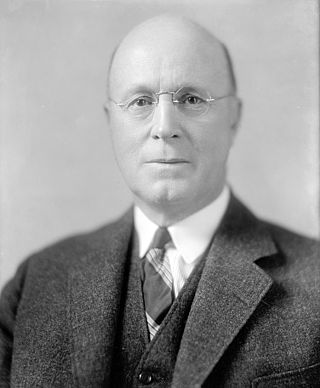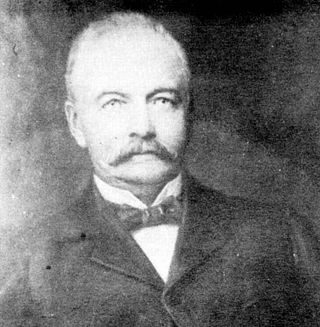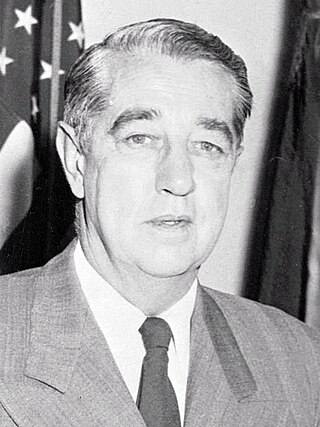Related Research Articles

Carson City is an independent city and the capital of the U.S. state of Nevada. As of the 2020 census, the population was 58,639, making it the 6th most populous city in the state. The majority of the city's population lives in Eagle Valley, on the eastern edge of the Carson Range, a branch of the Sierra Nevada, about 30 miles (50 km) south of Reno. The city is named after the mountain man Kit Carson. The town began as a stopover for California-bound immigrants, but developed into a city with the Comstock Lode, a silver strike in the mountains to the northeast. The city has served as Nevada's capital since statehood in 1864; for much of its history it was a hub for the Virginia and Truckee Railroad, although the tracks were removed in 1950.

Tasker Lowndes Oddie was an American attorney and politician who served as the 12th Governor of Nevada and a United States Senator. He was a member of the Republican Party.

Roswell Keyes Colcord was an American politician who served as the seventh Governor of Nevada from 1891 to 1895. He was a member of the Republican Party.

Charles Hinton Russell was an American politician who served as the 20th Governor of Nevada. He was a member of the Republican Party.

Richard Kirman Sr. was an American politician. He was the 17th Governor of Nevada from 1935 to 1939. He was a member of the Democratic Party.

John Henry Kinkead was an American businessman and politician who served as the third Governor of Nevada and the first Governor of the District of Alaska. Spending most of his life in the dry goods business, he was also Treasurer of Nevada Territory, a member of the Nevada Constitutional Convention in 1864, and the first United States official to hold office in Alaska.

Denver Sylvester Dickerson was an American politician. He was the 11th governor of Nevada from 1908 to 1911. A member of the Silver – Democratic coalition party, he had previously held office as the 13th lieutenant governor of Nevada from 1907 to 1908. During his governorship, Dickerson worked to reform the state prison system.

Reinhold Sadler was an American politician who was the 9th Governor of Nevada. He was a member of the Silver Party.

John Edward Jones was an American politician who was the eighth Governor of Nevada. He was a member of the Silver Party.

Charles Clark Stevenson was an American politician who was the fifth Governor of Nevada. He was a member of the Republican Party.

Maurice Joseph Sullivan was an American politician. He was the 15th and 18th lieutenant governor of Nevada and a U.S. Representative from Nevada. He was a member of the Democratic Party.

Horace Franklin Bartine was a United States representative from Nevada.

AbrahamVan Santvoord Curry is considered the founding father of Carson City, Nevada. A native of the state of New York, he traveled to the West Coast during the California Gold Rush and settled in Nevada's Eagle Valley, where Carson City was established.
Nellie Mighels Davis was a US civic leader and journalist. In 1897, she was the first woman to report a boxing prize fight (Fitzsimmons/Corbett) in the United States. She was also the first state president of the American Red Cross in Nevada, and an officer of the Pacific Coast Women's Press Association
Henry Rust Mighels was an American journalist and politician. A writer of the Sagebrush School, he was the editor and publisher of Carson City, Nevada's Nevada Appeal. He was born in Norway, Maine. He served in the Union Army during the American Civil War as assistant adjutant general, with the rank of captain, and was wounded in action. In 1868, he was elected State Printer and served a two-year term. In 1876, he was elected to the Nevada Assembly, serving as Speaker in 1877. The following year, he ran unsuccessfully for Lieutenant Governor of Nevada. He was also an artist, painting still life and landscapes. His one book, Sage Brush Leaves (1879), consists of literary essays. He died of cancer in 1879 in Carson City and is buried at Lone Mountain Cemetery next to his wife Nellie Verrill Mighels Davis. The Mighels had three sons, including Henry R. Mighels Jr. and Philip Verrill Mighels; and two daughters. Henry J. Mighels Jr. took over as editor of the Appeal in 1898. Philip's ex-wife, Ella Sterling Mighels, was the "First Literary Historian of California".

David Lawrence Gregg was an American politician from New York State. He rose to prominence in Illinois politics, first in the Illinois House of Representatives, then as United States Attorney, and Illinois Secretary of State. In 1853, Franklin Pierce appointed Gregg the Commissioner to the Kingdom of Hawaii to negotiate its annexation at the request of its king, Kamehameha III. In response, he cited the U.S. Constitution as not allowing annexation of a foreign state. His later years were spent in Carson City, Nevada.
Philip Verrill Mighels was an American writer and novelist. His early poems, short stories, and several of his novels, including his best-selling Bruvver Jim’s Baby and The Furnace of Gold, are part of the Sagebrush School of American literature. He was also a versatile and prolific author, recognized for his science fiction novels, romances, and political commentary. Less-known are his detective novels.

Lone Mountain Cemetery was a complex of cemeteries in the Lone Mountain neighborhood of San Francisco, California, United States on the land bounded by the present-day California Street, Geary Boulevard, Parker Avenue, and Presidio Avenue. Opened 1854, it eventually comprised Laurel Hill Cemetery, Calvary Cemetery, the Masonic Cemetery, and Odd Fellows Cemetery.

Henry C. Davis was an American politician who served as the sixth lieutenant governor of Nevada as a member of the Republican party from 1887 until his death in 1889. He was the first in the state's history to die in office.
References
- ↑ State, Nevada Secretary of (April 13, 1893). "Report" – via Google Books.
- ↑ "Past Pages for Friday, Jan. 3, 2014". www.nevadaappeal.com.
- ↑ "Politicians Buried in Lone Mountain Cemetery | Carson City". www.carson.org.
